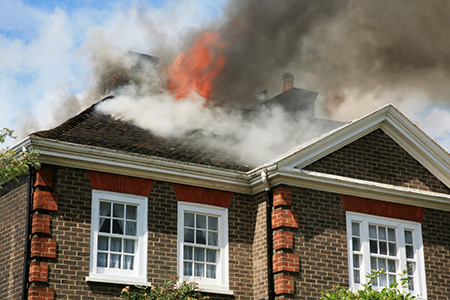Thirty years ago, a family living in a home that caught fire had about 15 to 17 minutes to escape unharmed. Today, that number has dropped to a harrowing three to four minutes. Read on to learn why and how you can prepare your house for fire safety during the holiday season and beyond.
They Just Don’t Make ’Em Like They Used To
Home fires move faster today. Two major culprits: modern, cheaply made furniture and synthetic fabric coverings. As wood furniture and natural linens are replaced with particle board and polyester, house fires spread faster. Synthetic fibers burn hotter and faster than natural fibers. An estimated 3,400 Americans died in fires in 2017, a number that has steadily increased since 2013. Residential fires also greatly outnumber nonresidential fires, contributing to 73% of fire deaths.
Risk of Home Fires Increases During
Holidays, Winter Months
According to the National Fire Protection Association, more home fires occur during the winter months than any other season of the year. There are many contributing factors, including:
- Heating – Heating is the second-leading cause of home fires, deaths and injuries. Space heaters especially contribute to this number. Always turn off all space heaters before falling asleep. Check your space heater for cracked or damaged cords and plugs. Plug space heaters directly into wall outlets and not into extension cords or power strips. Keep anything that can burn at least three feet from all heat sources, including fireplaces, wood stoves, radiators, space heaters or candles.
- Candles – More than one-third of home decoration fires are started by candles. If you can, replace real flame with flameless candles. If you do choose to light traditional candles, place them at least 12 inches away from anything that can burn. Never leave the home or go to sleep with candles burning.
- Christmas trees – A heat source too close to a Christmas tree causes one in four winter fires, and approximately one out of every 52 Christmas tree fires results in death. Trees must be at least three feet away from a heat source, should be trimmed with properly functioning lights and shouldn’t block any exits. Keep all trees well-watered, and discard promptly after the holidays.
Safety Checklist for Your Home
If you haven’t done a fire-safety check in your home, now is the time! Most importantly, make sure all of the smoke alarms in your home are working, and don’t forget to change those batteries once a year. Smoke alarms should be placed in every sleeping area, outside every sleeping area and on each floor.
Having a fire escape plan could mean the difference between life and death. Make a plan with your family to find two exits in every room, even if one of them is a window, and keep those exits clear. Download this home fire safety checklist and this home fire escape plan provided by the American Red Cross to help your family create a comprehensive plan.
